The legendary City of Light is a quintessential global city, and, despite France’s sad history of colonisation in North Africa, is widely seen as the Western advocate for Arab people. Out of the 68 million French population, around 10% is Muslim. Paris has a wide array of cultural & academic institutions promoting the Arab world, as well as libraries, restaurants, and a few buildings of Moorish influence – beyond the obvious Louvre Pyramid and Western Louxor Obelisk in Place de la Concorde!
Here is my 3-day itinerary. To follow my steps, you can use the following gmaps itineraries for Day 1, Day 2, Day 3 🙂.
Day 1
1 · iReMMO
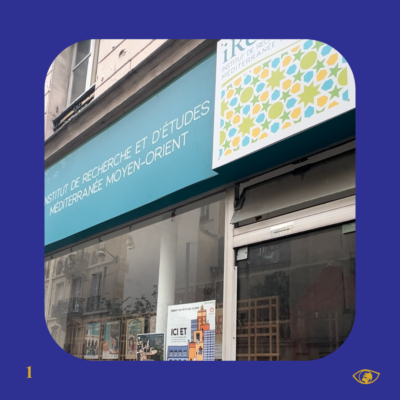 iReMMO is the Institute for Mediterranean Middle East Research and Studies. Its mission is to make scientific knowledge accessible to as many people as possible on the major political, cultural, economic and social issues linked to the regions of the Middle East and the Mediterranean basin.
iReMMO is the Institute for Mediterranean Middle East Research and Studies. Its mission is to make scientific knowledge accessible to as many people as possible on the major political, cultural, economic and social issues linked to the regions of the Middle East and the Mediterranean basin.
It publishes books, organises conferences, meetings, as well as training and research programmes. @institutiremmo
2 · Église Saint-Éphrem-le-Syriaque
 This Syriac Catholic church is dedicated to Saint Ephrem, a 4th century theologian in the region of Assyria and the author of several hymns and poems. The building is from the 18th century and was allocated in 1925 to the Syriac Catholic Mission in France.
This Syriac Catholic church is dedicated to Saint Ephrem, a 4th century theologian in the region of Assyria and the author of several hymns and poems. The building is from the 18th century and was allocated in 1925 to the Syriac Catholic Mission in France.
The Syriac Catholic Church is an Eastern Catholic Christian jurisdiction originating in the Levant that uses the West Syriac Rite liturgy and has many practices and rites in common with the Syriac Orthodox Church. It is a self-governed particular church, while in full communion with the Holy See the entirety of the Catholic Church.
The church is headed by Mor Ignatius Joseph III Younan, who has been the patriarch since 2009 and resides in Beirut, Lebanon.
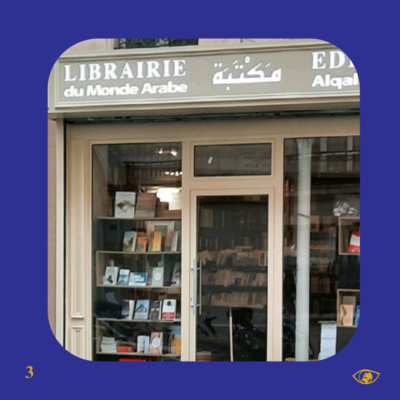 An independent bookstore specialised in the Arab world, it offers thousands of books in Arabic and French, covering everything on the Arab world and its civilisation: history, philosophy, art, Islam, and Arabic learning.
An independent bookstore specialised in the Arab world, it offers thousands of books in Arabic and French, covering everything on the Arab world and its civilisation: history, philosophy, art, Islam, and Arabic learning.
4 · Grand Mosque of Paris
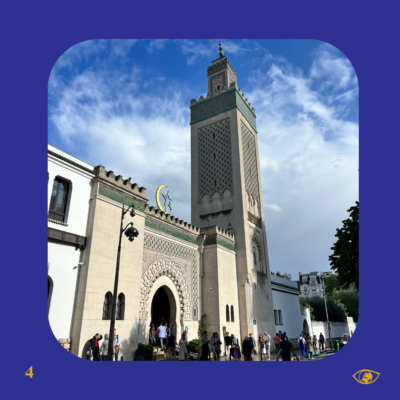 La grande Mosquée de Paris comprises prayer rooms, a magnificent outdoor patio and an Andalusian garden with jets of water, a small library, a gift shop, along with a cafe and restaurant. It is adjacent to a hammam, traditionally to facilitate ablutions required before prayer. Its construction was launched in 1921 on a land gifted by the city of Paris. Most of the craftsmen were from Morocco.
La grande Mosquée de Paris comprises prayer rooms, a magnificent outdoor patio and an Andalusian garden with jets of water, a small library, a gift shop, along with a cafe and restaurant. It is adjacent to a hammam, traditionally to facilitate ablutions required before prayer. Its construction was launched in 1921 on a land gifted by the city of Paris. Most of the craftsmen were from Morocco.
However, the very first presence of a Muslim worship site in Paris dates back to 1856 following a request from the Ottomans: it was a special enclosure reserved for the burial of Muslims in a division of the Cemetery Père Lachaise with a ‘Mosque’ in it, to give shelter to funerary services and the prayers for the deceased.
During World War II, the Mosque hosted Jewish families, who managed to flee thanks to underground passages adjacent to the Bièvre, a river that flows into the Seine.
Did you know? In France, the Muslim call to prayer is not allowed to be broadcast outside the Mosque, but inside. @mosqueeparis
5. INSP
 A governmental structure, it is dedicated to the recruitment, initial training and continuing education of senior executives and managers of the French state. It was created in 2022 to replace the tradional École nationale d’administration (ENA).
A governmental structure, it is dedicated to the recruitment, initial training and continuing education of senior executives and managers of the French state. It was created in 2022 to replace the tradional École nationale d’administration (ENA).
With its horseshoe-shaped door decorated with green and orange mosaics, the building resembles more a North African mosque than a French administrative school! Robert II (972-1031), son and successor of Hugues Capet, built the initial castle, named Hôtel de Valvert.
It was abandoned for more than a century and turned into a Carthusian monastery. After many other uses, it became the Colonial School in 1896. The architect Maurice Yvon chose neo-Moorish architecture and the School thus became a showcase of the colonial art of the Third Republic.
Day 2
 6 · Rue Notre Dame de Nazareth
6 · Rue Notre Dame de Nazareth
The name of the street refers to the convent of the fathers of Nazareth, located nearby. At number 15 you will find the Nazareth Synagogue, the oldest of the ‘great’ synagogues of Paris, which follows the Sephardi rite. The famous composer Jacques Offenbach was appointed, with his brother, to train and manage the choir for six months from December 1833.
7 · Passage du Caire
 Built in 1798, the Cairo passage is the oldest covered passage in the capital. It is named after the Egyptian capital because of the 3 statues of the goddess Hathor, with cow ears, adorning the entrance. The passage is known to be the longest and narrowest in Paris and is almost entirely dedicated to ready-to-wear wholesalers.
Built in 1798, the Cairo passage is the oldest covered passage in the capital. It is named after the Egyptian capital because of the 3 statues of the goddess Hathor, with cow ears, adorning the entrance. The passage is known to be the longest and narrowest in Paris and is almost entirely dedicated to ready-to-wear wholesalers.
The visit is worth a detour for the architecture of the beautiful facades of the upper level, which retain their original appearance. Many secondary entrances allow access to the passage: rue d’Alexandrie and rue du Caire.
8 · Anciens bains turcs
 Located 18 rue des Mathurins, the former Turkish baths establishment was built in 1876 by Albert Duclos and William Klein, with a double mission: to integrate with Haussmannian architecture while including oriental elements: friezes, columns, arches and railings inspired by mashrabiya.
Located 18 rue des Mathurins, the former Turkish baths establishment was built in 1876 by Albert Duclos and William Klein, with a double mission: to integrate with Haussmannian architecture while including oriental elements: friezes, columns, arches and railings inspired by mashrabiya.
It comprised a hammam, a massage parlor, a hairdresser and pedicure salon, a bookstore, a restaurant-cafe. The establishment was mainly used by men, but on certain days, women were able to come, using a more discreet door at n°47 boulevard Haussmann. The Turkish baths closed in 1954, and the interior decor was completely destroyed during the renovation of the building.
9 · Institut des cultures de l’Islam
 As known as ICI, it is a contemporary art center dedicated to the cultures of Islam. It organises and hosts events, performances, workshops, trainings and has a restaurant – tearoom, hammam and prayer room onsite. @institutculturesislam
As known as ICI, it is a contemporary art center dedicated to the cultures of Islam. It organises and hosts events, performances, workshops, trainings and has a restaurant – tearoom, hammam and prayer room onsite. @institutculturesislam
10 · La Maison Dar Dar
 It is previously known as “La maison d’Alep” and located 25, rue Ernestine. The Syrian know-how and traditional handcraft comes to the benefit of contemporary lightings, glassware, decorative items made of recycled blown glass. This shop collaborates with Syrian master glass blowers, in order supply its range of traditional cluster lights.
It is previously known as “La maison d’Alep” and located 25, rue Ernestine. The Syrian know-how and traditional handcraft comes to the benefit of contemporary lightings, glassware, decorative items made of recycled blown glass. This shop collaborates with Syrian master glass blowers, in order supply its range of traditional cluster lights.
11 · Rue de Palestine
 The street is named after Palestine because of the proximity of the Saint-Jean-Baptiste church in Belleville. The church is named after and dedicated to “John the Baptist” – or John the Forerunner in Eastern Orthodoxy, John the Immerser in some Baptist Christian traditions, and Prophet Yahya in Islam – a Judaean preacher active in the area of the Jordan River, Palestine, in the early 1st century AD.
The street is named after Palestine because of the proximity of the Saint-Jean-Baptiste church in Belleville. The church is named after and dedicated to “John the Baptist” – or John the Forerunner in Eastern Orthodoxy, John the Immerser in some Baptist Christian traditions, and Prophet Yahya in Islam – a Judaean preacher active in the area of the Jordan River, Palestine, in the early 1st century AD.
Day 3
12 · Institut du monde arabe
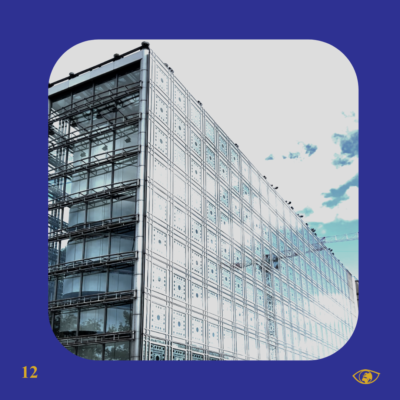 The Arab World Institute is a prominent organisation founded in Paris in 1980 by France and 22 Arab league states, initially to help strengthen ties with the oil-producing states, and to research and share information about the Arab world and its cultural and spiritual values. It hosts many quality exhibitions, conferences and guided tours.
The Arab World Institute is a prominent organisation founded in Paris in 1980 by France and 22 Arab league states, initially to help strengthen ties with the oil-producing states, and to research and share information about the Arab world and its cultural and spiritual values. It hosts many quality exhibitions, conferences and guided tours.
The Institute was established as a result of a perceived lack of representation for the Arab world in France, and seeks to provide a secular location for the promotion of Arab civilisation, art, knowledge, and aesthetics. Housed within the institution are a museum, library, auditorium, restaurant, offices and meeting rooms. @institutdumondearabe
13 · Maison du Maroc
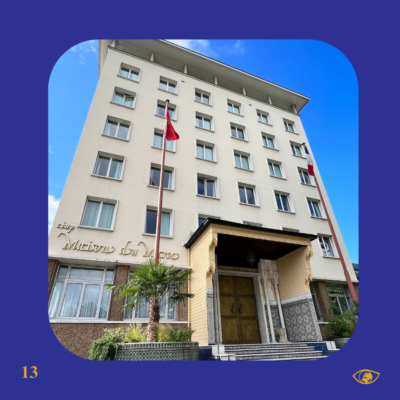 Built in 1953, the Maison du Maroc is one of the 40 houses of the Cité Internationale Universitaire de Paris (CIUP). Its objective is to serve both as a place of accommodation, meeting between students, researchers, visiting professors and artists and also to promote scientific and cultural exchange.
Built in 1953, the Maison du Maroc is one of the 40 houses of the Cité Internationale Universitaire de Paris (CIUP). Its objective is to serve both as a place of accommodation, meeting between students, researchers, visiting professors and artists and also to promote scientific and cultural exchange.
It comprises accommodation, a library, a traditional and original Moroccan lounge and an exhibition hall with works of resident, Moroccan and foreign artists. @fondation_maison_du_maroc
14 · Pavillon Bourguiba
 The Pavillon Habib Bourguiba is also located in CIUP and aims hosting Tunisian students while reinforcing academic, scientific and cultural cooperation between the France and Tunisia.
The Pavillon Habib Bourguiba is also located in CIUP and aims hosting Tunisian students while reinforcing academic, scientific and cultural cooperation between the France and Tunisia.
The impressive aluminium double skin made of Arabic script changes colours and reflects the sky. This metallic mesh evokes the tradition of mashrabiya in Tunisian architecture as well as Arab-Muslim calligraphy. The design of the Arab-Muslim lettering motifs were entrusted to the Tunisian calligraphy artist Shoof (Hosni Hertelli) and to Agence W & You under the artistic direction of the Galerie Itinerrance. In total, 1892 letters (no words) adorn the façade, following the building’s curvature.
I hope you enjoyed this escape to the Arab world as much as I did, which city would you like to see next?!
Bonus:
- For a brunch which makes you travel back in time with trendy music, try out Maison Constantine.
- For subtle Persian flavours in a colourful setting, try out Le Palais de la Perse (and check for offers on The Fork)
- I unfortunately did not have the chance to report on the interesting Ardi Concept Store, as it was closed for the Summer: it is a traditional Palestinian restaurant-caterer, cultural café, and delicatessen.
Related articles: Islamic Barcelona and Budapest. IslamiCities is a series showcasing Islamic influence in European cities through art, architecture, culture, lifestyle and gastronomy. This quest came to light pursuing my passion and fascination for Islamic art and architecture as well as the Arabic language. Cover picture: former Turkish baths building in Paris. For a time reference, the visit took place in August 2023.

